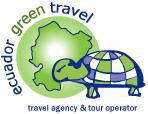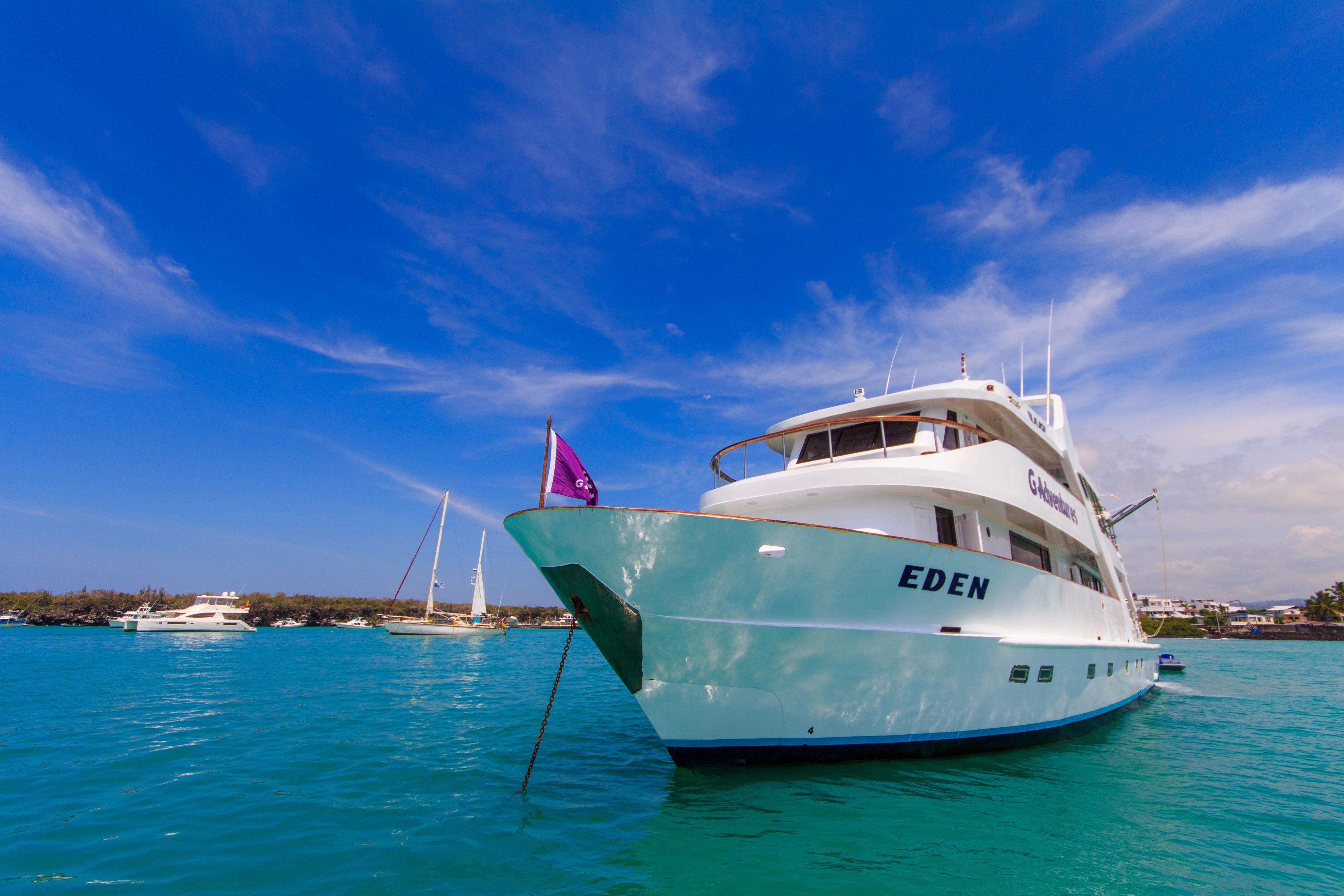DAY 1: TUESDAY
AM: SANTA CRUZ (INDEFATIGABLE) ISLAND – CHARLES DARWIN RESEARCH STATION
Santa Cruz is one of the inhabited islands to be visited during this itinerary. Puerto Ayora, with a population of about 25,000 people is the location of the Charles Darwin Research Station and Galapagos National Park main headquarters world famous for their tortoise breeding programs. After this visit, the passengers who finish the cruise must go to the airport to take the departure flight, the transfer is coordinated previously
PM: SANTA CRUZ (INDEFATIGABLE) ISLAND
The highlands After touring the Station, journey by bus to the highlands to go for a walk through the giant lava tubes and also have the unique opportunity to see the giant tortoises in the wild quite close to you in their natural surroundings. After this activity there will be some free time to explore the town of Puerto Ayora on your own.

DAY 2: WEDNESDAY
AM: SIERRA NEGRA VOLCANO
Your first visit in the morning will take place to Volcan Sierra Negra , will be a walk around 30 minutes to the lap of this famous volcano at Isabela Island. Volcan Sierra Negra is a large shield volcano at the South eastern end of Isabela Island in the Galapagos that rises to an altitude of 1124m. Also is considered one of the oldest Volcano at the Islands.
PM: HUMEDALES, MURO DE LAS LÁGRIMAS
In the afternoon after lunch, you will go to visit the humedales, which is a mangrove area with small brackish water lagoons that create the perfect environment for a small type of shrimp that serves as the food for the island’s flamingos.
The Wall of Tears is one of the remaining ruins of the penal colony that existed in Isabela between 1946 and 1958. The construction of this wall caused much suffering to the prisoners who were physically and psychologically tortured to carry the stones that make it up since long distance. The Wall of Tears is located at the end of the Wetlands route, on the way to the wall there is a viewpoint with a wonderful view of Puerto Villamil and you can also see giant tortoises in the wild along the way.

DAY 3: THURSDAY
MORNING: PUNTA MORENO
After night navigation you’ll arrive to Punta Moreno on the west coast of Isabela, a dry landing on a lava field. The vegetation found in this area is sparse and concentrated mainly in the mangrove area and around the lakes. It should be noted that the three kinds of cacti are found here. The main attractions at Punta Moreno are the coastal lagoons amid black lava flows where there are several species of birds. Here you’ll have a panoramic view of three of the most active volcanoes in the Galapagos, which are Sierra Negra, Cerro Azul of Isabela Island and La Cumbre of Fernandina Island.
PM: BAHÍA ELIZABETH
After lunch on board you’ll continue on your way to Elizabeth bay, located on Isabela Island`s west shore, which is an excellent spot for observing marine life. You’ll motor past a few islands where you can usually see Galapagos Penguins; this is one of the best areas to take their photos. A colony of these magnificent birds inhabit a rocky islet at the entrance to Elizabeth Bay. We’ll let our boat drift through a small passage lined with mangroves and eventually emerge into an enclosed cove. We’ll turn the motor off and look in the sheltered waters for Marine Turtles, Rays, Flightless Cormorants, Sea Lions, and, circling overhead, Galapagos Hawks.

DAY 4: FRIDAY
AM:PUNTA ESPINOZA
Punta Espinoza is a narrow ledge of lava and sand that extends from the base of the volcano to the sea. There is a vivid description from Captain Benjamin Morrell who witnessed and recorded and eruption of Fernandina in the 1820’s that probably gave rise to the Point. In 1975, there was an uprising, about 90 cm, which is why the pier built for landing can only be used during high tide. Punta Espinoza is a place famous for its large colonies of Marine Iguanas as well as being the habitat of unique species like the Flightless Cormorant, the Galapagos Penguin, the Galapagos Hawk, and the Galapagos Snake, among others. It’s an ideal place to observe the lava cactus (Brachycerus Nesioticus), which grow on young lava and survive with little water. Back on board for lunch and a short navigation to Punta Vicente Roca.
PM: PUNTA VICENTE ROCA DURING
Lunch time, we will start to navigate to Punta Vicente Roca on the northen tip of Isabela island, after a couple of hours we will arrive to this visitors place , the activity for the afternoon is snorkelling, Punta Vicente roca is home to sea lions, fur seals , penguins , turtles , flightless cormorants , so there is alway the opportunity to find any of this animals in the water. The snorkel takes place along a wall of volcanic ash called tuff stone featuring amazing underwater volcanic formations including a small cave where in season it is possible to see sea turtles. After snorkeling we will come back on board and continue on our way to James island.

DAY 5: SATURDAY
AM: PUERTO EGAS
James Bay is a black sand beach located on the west side of James Bay and northwest of Santiago Island. South of the beach is Sugarloaf Volcano, which has deposits of volcanic tuff, the same that helped the formation of the black sand beach. El Cráter is just north of this site, it has a saltwater lagoon, which during the summer dry season becomes a salt mine. Between 1928 and 1930 was the first exploitation of salt; but the efforts did not last long. Then again in 1964 a new attempt was made that lasted for some time. After lunch on board we’ll navigate to our next destination, Rabida.
PM: RÁBIDA
Rábida Island consists of a red sand beach, a coastal lagoon behind the beach, and a loop trail. The approximate distance of the trail is 1.1 kilometers. The color of the rocks and sand on the beach is due to the very porous volcanic material, which with the help of environmental factors (rain, salt water and sea breeze), has acted as an oxidizing agent. The main attraction of this spot is the red sand beach and scenery, aside from the vegetation of the arid zone and the presence of native and endemic species.

DAY 6: SUNDAY
AM: SEYMOUR NORTE - AIRPORT
After an early breakfast you’ll disembark at North Seymour Island. Here you will see Frigate Birds, the clownish Blue-Footed Booby, and of course the ubiquitous SeaLions. With luck you’ll witness the striking courtship display of the male Frigate Bird, in which he inflates a red balloon-like sac below his throat and struts his stuff for all of the young females. Seymour North, Plaza Sur, Plaza Norte, Baltra, northeastern Santa Cruz, Santa Fe and part of Española, were all formed by uprisings of underwater volcanic lavas. They were part of a volcanic lava table deposited in sheet form along cracks located on the ocean floor. The uprisings occurred sporadically and lasted more than a million years to reach its current level.
All marine fossils found in the archipelago are found in these islands and the best example is the North Channel side of Baltra. The fossils date from the Pleistocene, and specifically
in the case of Baltra, one can say that these volcanic tables were close to the surface about a million years ago. Return to the boat & sail to Baltra Island to catch your plane back to the mainland.
After an early breakfast you’ll disembark at North Seymour Island. Here you will see Frigate Birds, the clownish Blue-Footed Booby, and of course the ubiquitous SeaLions. With luck you’ll witness the striking courtship display of the male Frigate Bird, in which he inflates a red balloon-like sac below his throat and struts his stuff for all of the young females. Seymour North, Plaza Sur, Plaza Norte, Baltra, northeastern Santa Cruz, Santa Fe and part of Española, were all formed by uprisings of underwater volcanic lavas. They were part of a volcanic lava table deposited in sheet form along cracks located on the ocean floor. The uprisings occurred sporadically and lasted more than a million years to reach its current level.
All marine fossils found in the archipelago are found in these islands and the best example is the North Channel side of Baltra. The fossils date from the Pleistocene, and specifically
in the case of Baltra, one can say that these volcanic tables were close to the surface about a million years ago. Return to the boat & sail to Baltra Island to catch your plane back to the mainland.


























